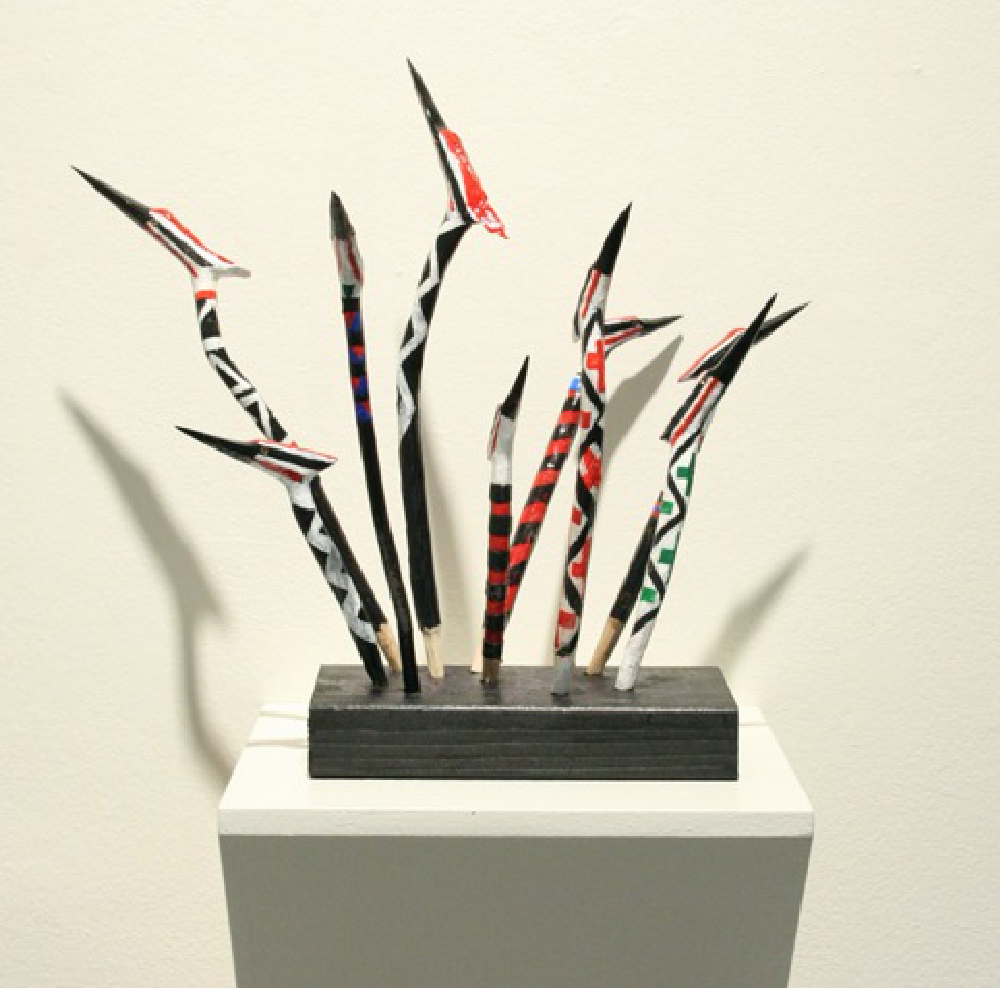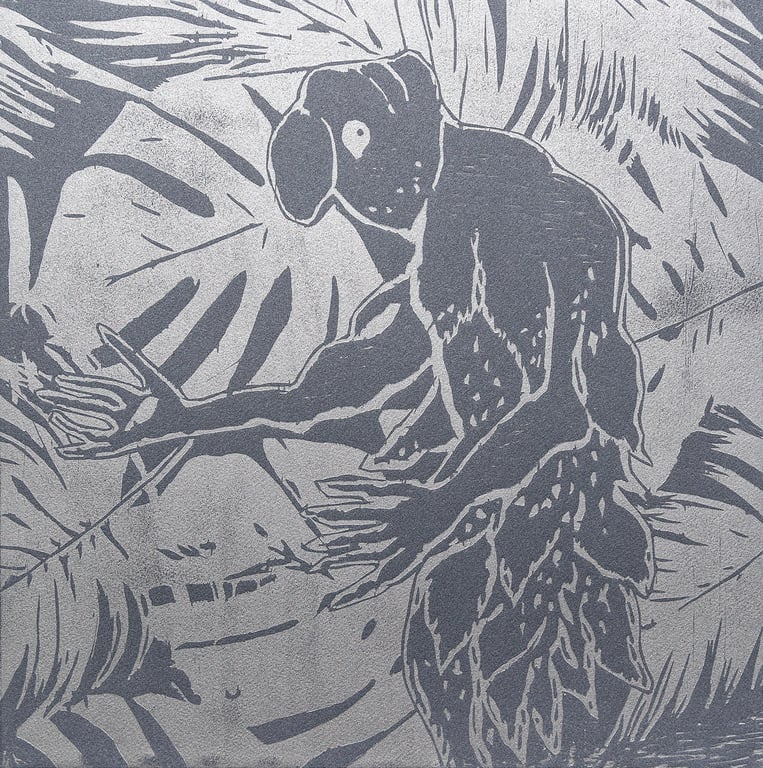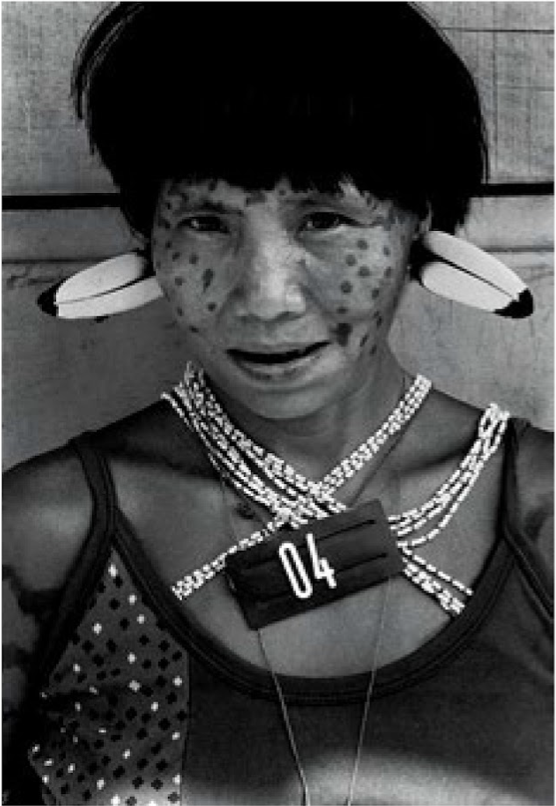
© » KADIST
Jorge González
Easy to fold and carry, Jorge González’s Banquetas Chéveres (Chéveres Stools) embody the nomadic and flexible nature of the Escuela de Oficios. González’s work employs a modernist language while paying homage to artisanal techniques specific to Puerto Rico and the Indigenous knowledge, people, and histories of the Carribean. Reinterpreting the furniture line ArKlu (1945-1948) conceived by the architects Stephen Arneson and Henry Klumb, the stools were conceived in collaboration with various artisans in Puerto Rico–Eustaquio Alers, a weaver from Aguadilla, Joe Hernández from Ciales, and MAOF from San Juan, a contemporary wood-salvaging collective, among others.

© » KADIST
Gabriel Chaile
For the project Aguas calientes Gabriel Chaile exchanged silverware from three popular soup kitchens (mutual aid organizations to provide food for people in need) in Buenos Aires to brand new cooking utensils to shape his project. Chaile then reworks the used goods, welding and engraving the names of their sites of provenance and imagery from local indigenous community’s visual repertoire; faces from vessels and iconography present in Cultura Tafí, Condorhuasi, Alamito, Santa María, Candelaria, and Ciénaga. Through this operation, he translates the idea of the “communal pot” into a meeting point for mutual cooperation and political resistance.

© » KADIST
Mazenett Quiroga
Gente Serpiente (Serpent People) is a piece made with the wheels of bikes, twisted, intertwined and painted like skins of tropical poisonous snakes. This sculpture, as well as other pieces by Mazenett and Quiroga, seeks to reveal and re-inscribe everyday and ordinary objects within a mythological tradition, to reconnect them with an origin in order to recognize their hidden life and meaning. These objects represent the life cycle and the animal, as well as cultural and geological time: long ago they were marine organisms and through the action of sand, sediment and mud, in oil, then in wheels they are transformed.

© » KADIST
Sky Hopinka
Dislocation Blues by Sky Hopinka is a portrait of the 2016 Standing Rock protests against the Dakota Access Pipeline in South Dakota. Working against grand narratives and myth-making, Hopinka attempts to provide a clear look towards the participants of the protest movement and the protectors of the water – their testimonies, reflections, and histories. In the film, Cleo Keahna tells about the everyday life of the camp and its difficulties and Terry Running Wild shares his dreams for the future.

© » KADIST
Sandra Monterroso
Drawing & Print (Drawing & Print)
Presented as part of a recent group of works titled The Paradox of Healing, Rhombus for Healing No. 2 by Sandra Monterroso brings together several of the artist’s interests: the use of ritual and medicinal elements; the conciliation of Western and indigenous formal languages; and more recently, sewing as a recognition and celebration of her maternal lineage. The series as a whole and this painting in particular continue her interest in textiles as visual references and cultural tools to address her native Guatemala’s complex political and cultural histories.

© » KADIST
Claudia Andujar
In 1980, with the construction of highways in Indigenous territories, an epidemic was brought to the Yanomami region. As the Yanomami do not have first names, it was necessary to give them numbers to indicate that they had already been vaccinated and identify each one for their medical records. From this series of events, Claudia Andujar’s Marcados series was born: what was supposed to be a mere photographic record, for organizational purposes, ended up raising a big question about the “labels” given to people in the construction of societies.

© » KADIST
Claudia Andujar
In 1980, with the construction of highways in Indigenous territories, an epidemic was brought to the Yanomami region. As the Yanomami do not have first names, it was necessary to give them numbers to indicate that they had already been vaccinated and identify each one for their medical records. From this series of events, Claudia Andujar’s Marcados series was born: what was supposed to be a mere photographic record, for organizational purposes, ended up raising a big question about the “labels” given to people in the construction of societies.

© » KADIST
Fernando Palma Rodríguez
Aqua by Fernando Palma Rodríguez is an installation formed by four gourds and one movement detector that activates them. Once put in motion, the gourds open and close hinged hands that are cut from their bodies, catalyzing a sophisticated, choreographed conversation among them. Following Indigenous notions of personhood, Palma Rodríguez grants agency to ordinary objects and therefore the ability to relate to others—humans as well as non-humans.

© » KADIST
Claudia Andujar
In 1980, with the construction of highways in Indigenous territories, an epidemic was brought to the Yanomami region. As the Yanomami do not have first names, it was necessary to give them numbers to indicate that they had already been vaccinated and identify each one for their medical records. From this series of events, Claudia Andujar’s Marcados series was born: what was supposed to be a mere photographic record, for organizational purposes, ended up raising a big question about the “labels” given to people in the construction of societies.
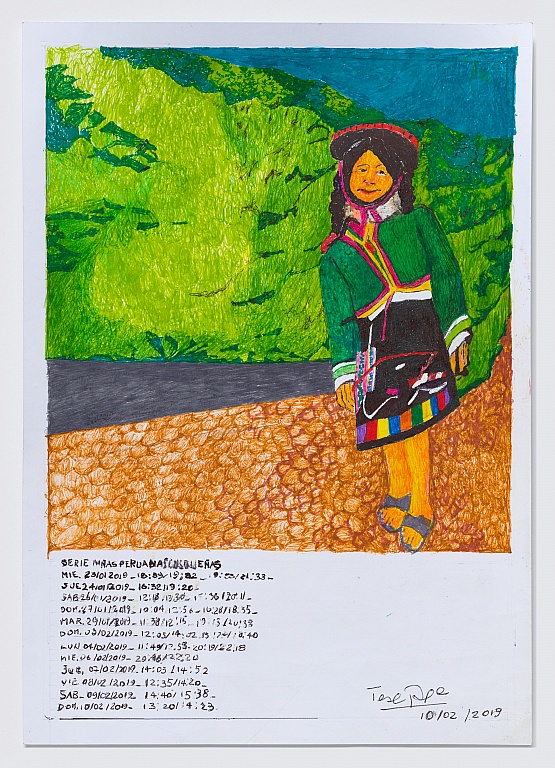
© » KADIST
Teresa Burga
Drawing & Print (Drawing & Print)
In her new series titled Ninas Peruanas Cusquenas , Teresa Burga depicts young indigenous women from Peru’s Andean region, dressed in traditional garments. Sourcing imagery from the internet, the drawings recall an untitled series of drawings from 1974, in which Burga selected images of women at random from various print media, and then rendered the images on paper. Those drawings, like the newer ones, suggest the perils of images without context––how assumptions are made, stereotypes are formed, and knowledge is gathered.

© » KADIST
Edgardo Aragón
In the agricultural areas of Mexico, Indigenous people use the mylar magnetic tape unspooled from VHS cassettes as an alternative to the scarecrow—the reflective tape flutters in the wind and does an excellent job scaring birds away from crops. This kind of creative reuse of materials (overproduced and devalued) that flow through the global trade of consumer goods, is especially rich in Mexico and other parts of Latin America. In 2020, during a period of isolation due to Covid-19, Edgardo Aragón unspooled a VHS tape and installed it in his father’s crop of corn for six months.

© » KADIST
Annie Pootoogook
Annie Pootoogook created COMPOSITION (EEGYVUDLUK DRINKING TEA) at a pivotal moment in her career. The drawing depicts her father Eegyvudluk Pootoogook, an Inuk printmaker and stone sculptor who died in 2000. Kin and kinship figure prominently in the artist’s work: Annie was the daughter of Napachie Pootoogook, a skilled draftswoman, and the granddaughter of renowned artist Pitseolak Ashoona.

© » KADIST
Pooja Gurung and Bibhusan Basnet
DADYAA: The Woodpeckers of Rotha by Pooja Gurung and Bibhusan Basnet illuminates a unique and seldom seen international perspective on indigenous cultures and contemporary social issues in the Nepali context. A small masterpiece, the work engages with one of the most pressing social issues in Nepal, mass migration and the dissolving of social fabric in rural areas. The story begins with an old couple, Atimaley and Devi, who live in a village in Jumla, in the highlands of Western Nepal.

© » KADIST
Claudia Martínez Garay
escenario chacana by Claudia Martínez Garay is a sculptural work composed of a frame-like structure that contains a series of ceramic pieces. It references the Chakana, an Andean cross that encompasses the different levels of existence (known as Pachas) and sacred elements contained in the Indigenous cosmologies of the region. It often appears in the geometrical motifs of textiles and ceramics.

© » KADIST
Naufus Ramírez-Figueroa
Naufus Ramírez-Figueroa’s performance Illusion of Matter establishes a dream state through a composition of motifs that were drawn from the artist’s childhood memories. Ramírez-Figueroa recreated the components of the dream as giant props made out of polystyrene, and set in a colorful yellow and orange mise-en-scene. Throughout the performance, the props and set are activated and demolished by children under the artist’s direction.

© » KADIST
Richard Bell
For Richard Bell, art is not simply a vehicle through which to represent and convey political content. On one hand, art itself has an activist charge—in its very form and presence it can shake up conventional or assumed understandings, opinions, and behaviours. But on the other hand, it is deeply implicated in the actions and attitudes associated with colonialism in Australia and abroad.

© » KADIST
Karla Kaplun
Drawing & Print (Drawing & Print)
Studying the body in movement, this series of drawings depart from Karla Kaplun’s work A ztec BLAST® Workout (AWB) . Taking the form of a fitness training program, this work critically explores issues of cultural appropriation, focusing on the traditional “Conchero” Aztec dance. The Concheros dance—also known as the Chichimecas, Aztecas and Mexicas—is an important traditional dance and ceremony which has been performed in Mexico since early in the country’s colonial period.

© » KADIST
Daniel Boyd
Daniel Boyd’s work WTEIA3 is part of a series of paintings that reference the stick charts used by indigenous communities on the Marshall Islands. These charts were made in order to navigate the Pacific ocean by canoe and thus crucially depict ocean swell patterns. These highly individualised maps were rarely intended for mass use but instead for memorising, and transmitting between the community, the maps were not taken to sea but instead memorised in advance.

© » KADIST
Reyes Santiago Rojas
The work Sarta (String) by Reyes Santiago Roja is part of a larger series of works that examine the commercialization of the tobacco plant and its relationship to the meaning and use of tobacco by Native American tribes such as the Mayas, Aztecs, Incas or Tainos, which attributed spiritual qualities to tobacco such as the smoke carrying one’s thoughts and prayers to the sprits. In this work the artist studied the forms of tobacco leaves native to Latin America and recreated their shapes with commercial tobacco packaging from such global brands as Marlboro or Camel to the most popular Colombian brand Pielroja. The leaves made of the packaging material are lined up on a string as if they are hung out to dry as in traditional tobacco making processes.

© » KADIST
Khvay Samnang
The video Rubber Man continues exploring issues related to land use, also noticeable in his Untitled series (2011). More specifically, Rubber Man addresses the French colonial legacy of land use for the exploitation of rubber –today exploited by multiple forces such as individuals, governments, multinationals and international banks– and its effects on Cambodia’s indigenous forests and culture today. The video takes place in Ratanakiri, an area in northeastern Cambodia increasingly known in local and international news for land grabs and protests, and where the artist frequently traveled to over two years.

© » KADIST
Nadia Myre
First exhibited as part of the recent multidisciplinary project Code Switching and Other Work , at Art Mûr, Berlin in late 2018, Nadia Myre’s Untitled (Tobacco Barrel) takes inspiration from the cylindrical vessels used to import tobacco from North America to Europe during periods of early colonial settlement. Responding to the history of clay pipe production in the ports of London, Bristol, and Glasgow by weaving together the literal detritus of the colonial tobacco trade, Myre’s work poetically untangles material links between the British Empire, Canada, and Indigenous peoples. Following contact with the so-called New World in the 1600s, the growing popularity of tobacco use in Europe led to the design and widespread manufacturing of disposable, pre-stuffed clay tobacco pipes in Britain.

© » KADIST
Brian Tripp
For many years Tripp has been involved in reviving Karuk ceremonies that had been discontinued for decades, he developed his signature abstract style, based in Karuk design, ceremonial regalia forms, and related cultural and political iconography. The two works in the KADIST collection are a continuation of these forms with in the medium of sculpture.

© » KADIST
Seba Calfuqueo
Alka domo by Seba Calfuqueo is a performative video work that recontextualizes a story about Caupolicán, the Mapuche toki (meaning symbol of strength and perseverance in the face of adversity). Caupolicán was elected military leader by the Mapuche people of Chile after successfully completing the challenge of holding a log on his shoulders for two days. Caupolicán led the Mapuche army in the first uprising against the Spanish conquistadors from 1553 to 1558.

© » KADIST
Sandra Monterroso
Sandra Monterroso’s video performance titled Corazón del lugar del viento (Heart of the Place of the Wind) is inspired by Seis Cielo (Six Sky), the only female Mayan ruler to be represented in classical Mayan stelae (historical monuments dedicated to the record of important events). As the artist impersonates the ruler and goddess, she performs a ritual of tying stones and an offering of clothing. Seis Cielo’s ties with the lineages of the prehispanic Tikal and Dos Pilas kingdoms were essential in understanding the role of Mayan women as mothers and wives, and especially as rulers and healers.
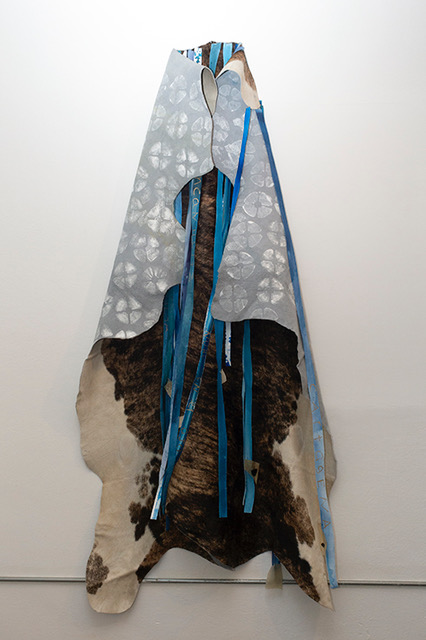
© » KADIST
Noé Martínez
As he investigates the forms that slavery took through different events that occurred during the sixteenth century in the Huasteca region of Mexico, Noé Martínez tells, in a non-linear narrative, the history of human trafficking in Relación de tráfico de personas 1525-1533 I (Study of Trafficking of Persons 1525–1533 I) . Both the departure of Huasteco Indians from the Americas, and the arrival of Africans from Cape Verde, Angola, Congo and Mozambique unravel in Martinez work as a story that has remained sealed in the colonial archives, and that continues under different guises in contemporary times. Relación de tráfico de personas 1525-1533 I is part of a series made of interventions in tanned leathers that refer to the exchange of human beings for pack animals and cattle in the Caribbean Sea.

© » KADIST
Karla Dickens
Karla Dickens’s collage Beneath the skim board addresses issues of discrimination and racism towards Indigenous communities in Australia through a constellation of historical and current events. Dickens spent over a year collecting and modifying ubiquitous objects into sculptural collages that commemorate former circus performers of Indigenous Australian descent. Assembled from various fabrics, knick-knacks and other materials, these frenetic compositions celebrate the campy glamour of circus performers, but also articulates the hidden mistreatment experienced by the performers, and more broadly, the lives of Indigenous communities in Australia.

© » KADIST
Zai Kuning
Drawing & Print (Drawing & Print)
Converting is a piece about the Orang Laut, often called Sea Nomads, that inhabited the Riau archipelago. They were Christians and pagans that were often oppressed by the majority Muslims in the Riau community and were eventually forced to convert to Islam. Zai conveyed this history in Converting through the stark contrasts of red, white, black.

© » KADIST
Dale Harding
Dale Harding’s installation Body of Objects consists of eleven sculptural works that the artist based on imagery found at sandstone sites across Carnarvon Gorge in Central Queensland. Mouth-blown with ochre on sandstone, these extraordinary stencilled images depict weaponry, domestic tools, and ceremonial objects that are specific to the region and that relate to Harding’s own ancestry. In response to these enduring indexes of Indigenous material culture, Harding produced a suite of cast objects using the stencilled imagery as a guide, along with objects that relate to his family history: boomerangs, spears, clubs, and whips are all part of the display.

© » KADIST
Subash Thebe Limbu
In Ningwasum , Subash Thebe Limbu explores Adivasi Futurism, a concept he has developed over a number of years, inspired by the writings of Octavia Butler, Afrofuturism, Indigenous Futurism, and various Adivasi, Janajati, feminist, queer, and Dalit movements. The video features an Indigenous, astronaut time traveller from the future, whose Indigenous nation not only co-exists with other nations and allies but also contains advanced technology that would appear magical to those from the present. Filmed mostly in the Himalayas, including the Wasanglung region in Eastern Nepal believed to be the shamanic home of the Yakthung, Ningwasum weaves oral narratives, animations, language, storytelling, soundscapes, and electronic music.

© » KADIST
Zai Kuning
Justice (2014) presents viewers with a curious assemblage: a wooden gallows with slightly curved spindles protruding from the topmost plank, which in turn is covered with rudimentary netting, the threads slackly dangling like a loose spider’s web or an rib cage that’s been cracked open. A bundle of small red rattan balls hang from the front end of the plank, precariously knotted to a single thread hanging from the gallows’ edge. A book hangs from similar red threads at the plank’s rear, its surfaced wrapped multiple times over with the thread to hold it in place, the red thread resembling blood vessels or connective tissue.
Claudia Andujar
Claudia Andujar was born in Switzerland in 1931, and then moved to Oradea, on the border between Romania and Hungary, where her paternal family, of Jewish origin, lived...
Zai Kuning
- year born: 1964
- gender: male
- nationality: Singaporean
- home town: Singapore
Brian Tripp
Brian D...
Sandra Monterroso
Sandra Monterroso is a Guatemalan artist of Maya Q’eqchi’ decent...
Karla Kaplun
Karla Kaplun’s practice centers on micro-utopias, the construction and functioning of collective memory, as well as mechanisms of political and economic power and control...
Khvay Samnang
Khvay Samnang’s work critically examines the interlocking nature of ritual and politics, the humanitarian and ecological impacts of globalization, colonialism and migration, and the cultural-material histories of exchange that have shaped the Southeast Asia region...
Subash Thebe Limbu
Subash Thebe Limbu considers his works to be science fiction through an Indigenous lens, rooted in the language, script, songs, and symbols of the Yakthung (Limbu) peoples...
Rocky Cajigan
Rocky Cajigan is a Bontoc Igorot artist working in the contemporary contexts of Indigenous people from the Cordilleras region in the northern state of Luzon island in the Philippines...
Teresa Burga
A pioneer of Latin American Conceptualism, since the 1960s, Teresa Burga has made works that encompass drawing, painting, sculpture, and conceptual structures that support the display of analytical data and experimental methodologies...
Annie Pootoogook
An instinctive chronicler of her generation, Annie Pootoogook hailed from a long line of artists in Cape Dorset (known today as Kinngait), Nunavut...
Elyla
Elyla (Fredman Barahona) is a performance artist and queer activist...
Mazenett Quiroga
Mazenett Quiroga have been working collaboratively in Bogotá, Colombia for the past nine years...
Nguyen Trinh Thi
Nguyen Trinh Thi is a moving image pioneer, not only within the landscape of contemporary art in Vietnam, but also broader South East Asia...
Mercedes Dorame
Mercedes Dorame is a photographer and member of the Tongva tribe in Los Angeles...
Newell Harry
Newell Harry’s practice traces an intimate web of connections and histories linking Pacific island cultures (especially those of the Vanuatu archipelago)–via Australia, where he lives, and the Malay world–to South Africa’s Western Cape Province, the home of his extended family...
Nadia Myre
The work of Nadia Myre, member of the Kitigan Zibi Anishinabeg First Nation, is notable for its embrace of cross-cultural mediations as a strategy towards celebrating and reclaiming the far-reaching intellectual and aesthetic contributions of Indigenous communities...
Gabriel Chaile
Gabriel Chaile’s work draws on references ranging from Pre-Columbian cultures to Conceptualism in often-usable sculptures involving bricks, adobe structures, and other found objects...
Pooja Gurung and Bibhusan Basnet
Pooja Gurung and Bibhusan Basnet have a joint practice that merges film and visual art...
Carolina Caycedo
Carolina Caycedo’s work triumphs environmental justice through demonstrations of resistance and solidarity...
Seba Calfuqueo
Seba Calfuqueo is an artist of Mapuche origin whose work critically reflects on the social, cultural, and political status of the Mapuche people in contemporary Chilean society...
Dale Harding
A descendant of the Bidjara, Ghungalu, and Garingbal peoples, Dale Harding’s work references and expands upon the philosophical and spiritual touchstones of his cultural inheritance...
Daniel Boyd
Daniel Boyd is an indigenous Australian Pacific artist, in his practice he combines references to both Aboriginal art and international contemporary art, displaying a strong political commitment...
Edgar Calel
Edgar Calel is a Maya Kaqchikel artist and poet from the midwestern highlands of Guatemala...
Noara Quintana
Noara Quintana’s research-based practice focuses on the materiality of everyday objects and their interconnection with sociopolitical and historical processes in the Global South...
Sky Hopinka
Sky Hopinka is from the Ho-Chunk Nation/Pechanga Band of Luiseño Indians...
Karrabing Film Collective
Karrabing Film Collective is an indigenous media group consisting of over 30 members, bringing together Aboriginal filmmakers from Australia’s Northern Territory...
Reyes Santiago Rojas
Reyes Santiago Rojas works with themes relates to nature, patience and garbage...
Karla Dickens
Karla Dickens is a Wiradjuri artist whose work spans sculpture, textiles, poetry, painting, photography, and found material collage...
Richard Bell
Richard Bell works across a variety of media including painting, installation, performance and video and text to pose provocative, complex, and humorous challenges to our preconceived ideas of Aboriginal art, as well as addressing contemporary debates around identity, place, and politics...
Olive Martin and Patrick Bernier
Patrick Bernier and Olive Martin are a duo of artists collaborating since 1999...
-
1980-1989
Claudia Andujar
1984In 1980, with the construction of highways in Indigenous territories, an epidemic was brought to the Yanomami region...
Claudia Andujar
1984In 1980, with the construction of highways in Indigenous territories, an epidemic was brought to the Yanomami region...
Claudia Andujar
1984In 1980, with the construction of highways in Indigenous territories, an epidemic was brought to the Yanomami region...
Claudia Andujar
1984In 1980, with the construction of highways in Indigenous territories, an epidemic was brought to the Yanomami region...
-
2000-2009
Annie Pootoogook
2006Annie Pootoogook created COMPOSITION (EEGYVUDLUK DRINKING TEA) at a pivotal moment in her career...
-
2010-2019
Brian Tripp
2010For many years Tripp has been involved in reviving Karuk ceremonies that had been discontinued for decades, he developed his signature abstract style, based in Karuk design, ceremonial regalia forms, and related cultural and political iconography...
Olive Martin and Patrick Bernier
2010The Mohawk, the emblematic Frontier river in the period of American colonisation, is here a cable of data transmission, and the 7 Sultans Casino is a virtual destination, one of the three hundred online casinos hosted by the servers located in Kahnawake, a small native american indian reserve to the south of Montreal...
Brian Tripp
2010For many years Tripp has been involved in reviving Karuk ceremonies that had been discontinued for decades, he developed his signature abstract style, based in Karuk design, ceremonial regalia forms, and related cultural and political iconography...
Khvay Samnang
2014The video Rubber Man continues exploring issues related to land use, also noticeable in his Untitled series (2011)...
Zai Kuning
2014Justice (2014) presents viewers with a curious assemblage: a wooden gallows with slightly curved spindles protruding from the topmost plank, which in turn is covered with rudimentary netting, the threads slackly dangling like a loose spider’s web or an rib cage that’s been cracked open...
Zai Kuning
Drawing & Print
2014(Drawing & Print) Converting is a piece about the Orang Laut, often called Sea Nomads, that inhabited the Riau archipelago...
Zai Kuning
Drawing & Print
2014(Drawing & Print) Concerned with the early history of Singapore, Zai Kuning spent many years living with and researching the history of the Riau peoples who were the first inhabitants of Singapore...
Carolina Caycedo
2014YUMA o la tierra de los amigos (YUMA, or the Land of Friends) by Carolina Caycedo is a large mural containing a series of satellite photographs mounted on acrylic...
Reyes Santiago Rojas
2015The work Sarta (String) by Reyes Santiago Roja is part of a larger series of works that examine the commercialization of the tobacco plant and its relationship to the meaning and use of tobacco by Native American tribes such as the Mayas, Aztecs, Incas or Tainos, which attributed spiritual qualities to tobacco such as the smoke carrying one’s thoughts and prayers to the sprits...
Naufus Ramírez-Figueroa
2015Naufus Ramírez-Figueroa’s performance Illusion of Matter establishes a dream state through a composition of motifs that were drawn from the artist’s childhood memories...
Fernando Palma Rodríguez
2015Aqua by Fernando Palma Rodríguez is an installation formed by four gourds and one movement detector that activates them...
Newell Harry
2015(Untitled) Nimoa and Me: Kiriwina Notations by Newell Harry brings together a litany of contemporary politics—mobilization around enduring racism, the legacies of Indigenous and independence struggle, and the prospects of global solidarity against neocolonialism and social injustice...
Aline Baiana
2016Indigenous educator and curator Sandra Benites, of the Guarani-Ñandeva people, narrates the origin myth of the bird Urutau in her native language...
Daniel Boyd
2017Daniel Boyd’s work WTEIA3 is part of a series of paintings that reference the stick charts used by indigenous communities on the Marshall Islands...
Jorge González
2017Easy to fold and carry, Jorge González’s Banquetas Chéveres (Chéveres Stools) embody the nomadic and flexible nature of the Escuela de Oficios...
Seba Calfuqueo
2017Alka domo by Seba Calfuqueo is a performative video work that recontextualizes a story about Caupolicán, the Mapuche toki (meaning symbol of strength and perseverance in the face of adversity)...
Sky Hopinka
2017Dislocation Blues by Sky Hopinka is a portrait of the 2016 Standing Rock protests against the Dakota Access Pipeline in South Dakota...
Khvay Samnang
2017Originally commissioned for documenta 14, Khvay Samnang’s two-channel video work Preah Kunlong (The way of the spirit) takes land politics, resource extraction and Indigenous Cambodian resistance as its primary concern...
Rocky Cajigan
2017From the Ending by Rocky Cajigan consists of an assemblage painting, with accompanying sculptural objects presented on the floor...
Antonio Pichillá
2017Wind by Antonio Pichillá is a textile piece depicting the glyph that represents the element wind in the Mayan tradition...
Rocky Cajigan
2017From the Beginning by Rocky Cajigan consists of an assemblage painting, with accompanying sculptural objects presented on the floor...
Pooja Gurung and Bibhusan Basnet
2018DADYAA: The Woodpeckers of Rotha by Pooja Gurung and Bibhusan Basnet illuminates a unique and seldom seen international perspective on indigenous cultures and contemporary social issues in the Nepali context...
Dale Harding
2018Dale Harding’s installation Body of Objects consists of eleven sculptural works that the artist based on imagery found at sandstone sites across Carnarvon Gorge in Central Queensland...
Nadia Myre
2018First exhibited as part of the recent multidisciplinary project Code Switching and Other Work , at Art Mûr, Berlin in late 2018, Nadia Myre’s Untitled (Tobacco Barrel) takes inspiration from the cylindrical vessels used to import tobacco from North America to Europe during periods of early colonial settlement...
Bayrol Jiménez
2018Sombras de los Valles (Shadows of the Valleys) is part of a series of works created by Bayrol Jiménez in which he is influenced by hand-painted signs and large billboards in Mexico...
Mercedes Dorame
2018Mercedes Dorame utilizes photography to investigate, recode, and connect with her Gabrielino-Tongva tribe culture, as well as to bring current Indigenous experiences to light...
Karrabing Film Collective
2018The Mermaids, or Aiden in Wonderland by Karrabing Film Collective is a surreal exploration of Western toxic contamination, capitalism, and human and non-human life...
Claudia Martínez Garay
2019escenario chacana by Claudia Martínez Garay is a sculptural work composed of a frame-like structure that contains a series of ceramic pieces...
Gabriel Chaile
2019For the project Aguas calientes Gabriel Chaile exchanged silverware from three popular soup kitchens (mutual aid organizations to provide food for people in need) in Buenos Aires to brand new cooking utensils to shape his project...
Mazenett Quiroga
2019Gente Serpiente (Serpent People) is a piece made with the wheels of bikes, twisted, intertwined and painted like skins of tropical poisonous snakes...
Teresa Burga
Drawing & Print
2019(Drawing & Print) In her new series titled Ninas Peruanas Cusquenas , Teresa Burga depicts young indigenous women from Peru’s Andean region, dressed in traditional garments...
Noé Martínez
2019As he investigates the forms that slavery took through different events that occurred during the sixteenth century in the Huasteca region of Mexico, Noé Martínez tells, in a non-linear narrative, the history of human trafficking in Relación de tráfico de personas 1525-1533 I (Study of Trafficking of Persons 1525–1533 I) ...
Karla Dickens
2019Karla Dickens’s collage Beneath the skim board addresses issues of discrimination and racism towards Indigenous communities in Australia through a constellation of historical and current events...
Karla Kaplun
Drawing & Print
2019(Drawing & Print) Studying the body in movement, this series of drawings depart from Karla Kaplun’s work A ztec BLAST® Workout (AWB) ...
Noara Quintana
2019The series Belle Époque of the Tropics by Noara Quintana has as its background the history of the rubber industrialization in North of Brazil...
Karla Kaplun
Drawing & Print
2019(Drawing & Print) Studying the body in movement, this series of drawings depart from Karla Kaplun’s work A ztec BLAST® Workout (AWB) ...
-
2020-2029
Edgardo Aragón
2020In the agricultural areas of Mexico, Indigenous people use the mylar magnetic tape unspooled from VHS cassettes as an alternative to the scarecrow—the reflective tape flutters in the wind and does an excellent job scaring birds away from crops...
Edgar Calel
2020The point of departure for Xar – Sueño de obsidiana by Edgar Calel is a poem that the artist wrote in Maya Kaqchikel...
Subash Thebe Limbu
2021In Ningwasum , Subash Thebe Limbu explores Adivasi Futurism, a concept he has developed over a number of years, inspired by the writings of Octavia Butler, Afrofuturism, Indigenous Futurism, and various Adivasi, Janajati, feminist, queer, and Dalit movements...
Nguyen Trinh Thi
2021The essay film How to Improve the World by Nguyen Trinh Thi takes us into an indigenous village of the Jrai people in the Central Highlands of Vietnam, in Gia Lai province...
Subash Thebe Limbu
2021In Ningwasum , Subash Thebe Limbu explores Adivasi Futurism, a concept he has developed over a number of years, inspired by the writings of Octavia Butler, Afrofuturism, Indigenous Futurism, and various Adivasi, Janajati, feminist, queer, and Dalit movements...
Nikau Hindin
2021Maori barkcloth making is the central artistic form in the Pacific, and still at the core of cultural expression in many Pacific countries...
Richard Bell
2022For Richard Bell, art is not simply a vehicle through which to represent and convey political content...
Sandra Monterroso
2022Sandra Monterroso’s video performance titled Corazón del lugar del viento (Heart of the Place of the Wind) is inspired by Seis Cielo (Six Sky), the only female Mayan ruler to be represented in classical Mayan stelae (historical monuments dedicated to the record of important events)...
Sandra Monterroso
Drawing & Print
2023(Drawing & Print) Presented as part of a recent group of works titled The Paradox of Healing, Rhombus for Healing No...

